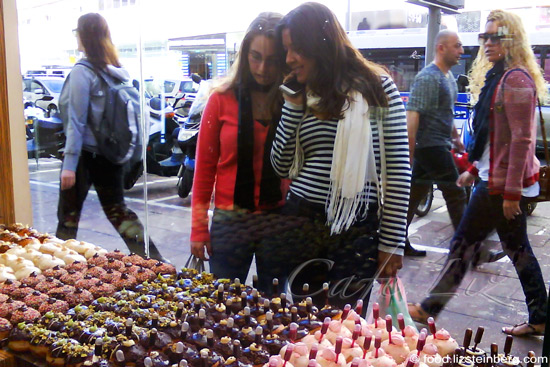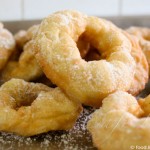
I’m going to admit it — I’m not into Roladin donuts. We may have another week to go until Hanukkah begins, but the Roladin donuts have been out in force for a while now, due to popular demand (and marketing). I must be the only person in the country who isn’t, to judge by the lines outside each store starting shortly before the holiday. I mean, I get it — those are beautiful donuts, and you have to hand it to the company for innovation, with lots of new flavors every year.
But they’re just so … sweet.

The Roladin crowd last year.
After all, what makes them so pretty is the layers upon layers of frosting. And not to be a grinch, but this is the holiday for eating oil, not flavored sugar. I presume the actual donut underneath is halfway decent, if not downright good, but frankly I can never actually tell.

Now, I love me a good donut, and for me that means taking a bite into a golden, lightly crisp shell to find that effervescent yeasty flavor inside, that taste that starts dissipating immediately after the donut comes out of the oil. This is the kind of donut that justifies eating deep-fried dough.
And baking guru Carine Goren’s donut recipe fits the bill perfectly. The recipe comes by way of Miriyummy, who posted about it with her own adjustments.
I adapted the recipe somewhat — the original calls for topping the donuts with powdered sugar and serving them with filling of some sort, like jam. But after taking one bite of these donuts, I can tell you that that’s heresy — they should be eaten naked as the moment they were fried, for any adornment overwhelms and conceals that yeasty flavor that makes them so special.
I mean, if you want adornment, you might as well just go to Roladin.
The original recipe (in Hebrew) uses 1 kilo of flour to make 30 large donuts, while Miriyummy replaced the brandy with vanilla and halved the recipe, which I found made 30 medium-sized donuts last year — which is a good quantity if you want to invite all your friends (well, not all, but you know what I mean). I’ve since reduced the recipe even further, because let’s be honest, a dozen medium-sized donuts is plenty for an intimate gathering. Even if you and all your guests want to be greedy.
The brandy called for in the original supposedly keeps donuts from absorbing too much oil, but I didn’t notice that that was a problem here.
I found the ideal frying temperature to be between 150 and 160 degrees Celsius — much cooler than I fried my sfenj, for instance — since these donuts need some time to let the heat penetrate to the center. A kitchen thermometer is great for taking away the guesswork and making sure you don’t burn the first batch.
And here’s a cool tip from Carine to keep your donuts perfectly round: Once you’ve broken the dough into balls, place them on little squares of baking paper to rise a second time. This way, you can use the paper to lift them and drop them straight into the oil without leaving finger indentations in the soft dough. The paper will fall off into the oil, and you can just pull it out. I didn’t find this necessary, since I was able to lift my donuts without causing too much harm, but it’s a good trick to know.
For 10-12 donuts, depending how large you make them:
- 1 3/4 cup flour
- 1/3 cup warm milk
- 2 tablespoons sugar
- 1 egg
- 2 tablespoons butter
- 1/2 tablespoon vanilla
- 1/2 teaspoon lemon peel (zest of 1/4 lemon)
- 1/2 teaspoon yeast
- oil for deep frying
Mix together all the ingredients, and let rise until doubled in bulk — at this cold time of year, you might want to do so in a lightly heated oven (turn the oven on for 2-3 minutes, turn off, then insert the bowl with the dough). Otherwise, you’ll be waiting until Purim for your donuts.
Punch down, knead lightly and break into walnut-sized balls. Arrange on an oiled sheet to rise again (or, for the pedantic, on little squares of baking paper so you can lift them without ruining their perfect round exteriors). Wait until they double in size.
Heat enough oil to deep-fry the donuts in a wok or some other pot you want to season (because scrubbing oil residue off your spotless stainless steel is a pain). The oil needs to be deep enough that the donuts can float halfway emerged without touching the bottom of the pot.
Once the oil is between 150 to 160 degrees Celsius, drop in your first batch of donuts, let brown on the bottom, flip, let brown on the top, and then remove to a paper towel to soak up excess oil. This temperature should let the donuts fry somewhat slowly, so that the heat penetrates to the inside and bakes them throughout — basically, if they’re instantly browning, this means you’re going to have raw interiors (or blackened exteriors).
(If you don’t have a thermometer — 150-160 is the temperature at which bubbles will gently start coming off the sides of a donut dropped into the oil.)
Eat as soon as the donuts are cool enough to touch.





